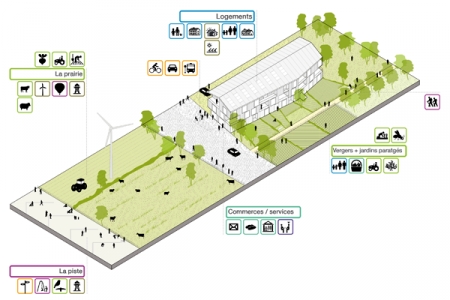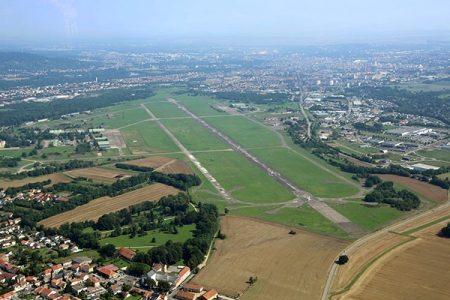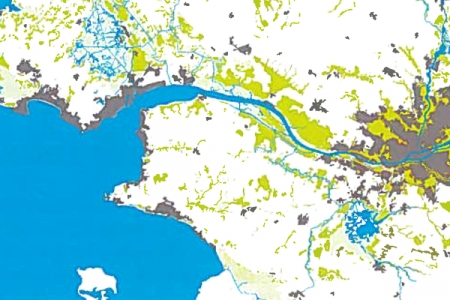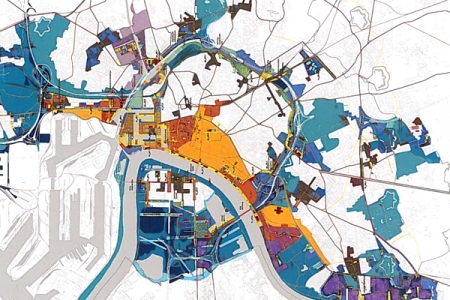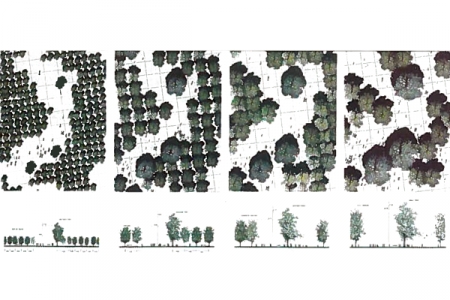BA 128 Résonnances économes
Metz (FR) – Winner
TEAM DATA
Team Representative: Laetitia Lafont (FR) – architect urbanist ; Associate: Thomas Verges (FR) – landscape architect
Contributor: Mathilde Catalan (FR) – architect
Atelier Laetitia Lafont, 42 rue d'Avron, 75020 Paris – France
+33 6 75 81 45 51 – atelierlaetitialafont@gmail.com – www.atelierlaetitialafont.com
See the complete listing of portraits here
See the site page here

T. Verges & L. Lafont
INTERVIEW
Click on the images to enlarge
1. How did you form the team for the competition?
Our collaboration was born from a meeting in the Urban Planning office Obras in Paris. We share the same visions on the fabrication and/or the regeneration of urban territory and environments. The BA128 site in Metz, a 340 ha piece of land completely enclosed, has become a perfect laboratory for many interconnecting problems: ecology, landscape, agriculture, urban & architecture, issues that are at stake around both local programs and more global issues. We work on a daily basis on the questions of urban territory fabrication by our professional experiences and on the numerous questions posed whilst being an architect, an urban designer and a landscape architect: from the national to the urban, architectural and detail scale, on the question of the rehabilitation of listed heritage, of vernacular or of commonplace architecture.
2. How do you define the main issue of your project, and how did you answer on this session main topic: Adaptability through Self-Organization, Sharing and/or Project (Process)?
Air Base 128 in Metz is a large, enclosed and disused piece of urban land. Unable to either maintain or transform their military sites, the State is disposing of a certain number of them. The project therefore, aims to anticipate this evolution by opening the site to the local territory –the town of Metz– thus maintaining the economical, social and environmental occupations of this area in order to think about its future development. The project proposes a progressive and reasonable opening schedule for the site, using a controlled phasing, introducing a succession of pilot programs (recycling centre, public paths), followed by expansion programs (ecological centre, agrobiology centre, housing, offices) and then later, reinforcing amenities (sports centre, entertainment venues, business activities). The land of the Frescaty Plateau offers a wide range of constructible and landscaping resources, local know-how, able to participate in the integration of the project. This process requires finding the resonance and the solidarity at local level (Metz urban agglomeration) but also on a global (European) scale in order to continue and expand the interfaces, in particular with the ecological and agrobiological programs.
3. How did this issue and the questions raised by the site mutation meet?
The project is settled amongst the existing heritage structures, interlaced into the landscape, the infrastructure and the existing activities and buildings. Both the identity of the urban territory and its current dynamism define the site, and visa-versa. The transformation process uses as a starting block the existing intrinsic qualities of the site. Beyond the functions that help maintain the existence of an urban area and therefore guarantee its sustainability, an urban project cannot have a fixed horizon. The project thus envisages using a collective backdrop, which can then be interpreted later for individual use. This means a network of sound publics spaces set out within a structured layout (landscape, built forms, road systems….) that are perfectly adaptable for future land ownership, be it private or public investment. The modularity of dividing boundaries, the various programs and the different processes, allow the project to evolve and redefine the neighbourhood by creating a strong identity while at the same time installing a flexible development.
Within a structured urban tissue, the spaces can change and fluctuate emphasising the landscape whilst redefining the borders to recreate the continuity between the urban forms of the Seille and the Moseille Rivers. The projects flexible character is reinforced by the dynamic rhythm of the urban management (removable furniture, program events, the design of flexible & multi-used spaces, changeable…).
4. Have you treated this issue previously? What were the reference projects that inspired yours?
We are currently working on a project in Savenay following the winning entry for Europan 11; dealing with the elaboration of an urban strategy and a masterplan for the creation of a new district –South of the Pôle d'Echange Multimodal– it also approaches this problem of redefining an abandoned and isolated urban land. Situated halfway between Nantes and Saint-Nazaire, Savenay is a town that has the highest population growth within the area of the estuary valley. As such, in order to fulfil the ambitions and challenges of the urban planning and thus the guidelines of the Metropolitan Centre, the idea would be to create new suburban model across the Loire Estuary Valley.
At the scale of the town, the area around the railway station raises some very genuine questions: what to do with this industrial zone, lying at the foot of the town centre, on the other side of the railway lines?
The project proposes a series of "Loire Guidelines", a useable toolbox that allows the coordination of a progressive and mixed development. We are working on an urban composition associating 'inhabited' forms (housing, retail, businesses) with 'active' forms (artisanal activities, office spaces) within an existing but reinforced wooded and vegetal environment. The hydraulic infrastructure becomes the preceding negative to the urban project. The surrounding flat landscape is prolonged into the heart of the area, redrawn to find new alliances and cohabitations within the natural, inhabited and active environments.
5. Today –at the era of economic crisis and sustainability– the urban-architectural project should reconsider its production method in time; how did you integrate this issue in your project?
Both the cross-border dynamics of the Metz agglomeration and the large-scale dimensions of the site lead us to question the fabrication process, the coordination and of the management of an urban project of this scale. This is why, in order to address local and regional issues, the project brings together the public motivation and the initiatives from the individual inhabitants. Through the various programs and functions, the project challenges the traditional fabrication method. The involvement of the local inhabitants from the beginning is essential to develop and ensure a shared identity of the place.
- The recycling centre is the pilot program of the project. Presented at the beginning, this tool will orchestrate the procession of demolitions and decontamination as a first phase, sorting and recycling as a second, and in the end, the recycling centre will propose a renewal and reuse of materials in the project throughout its transformation process (public space, energy, construction…);
- The landing strip, a path traced in the history of the place, becomes the central public space. Structured around this great wide space of the landing strip, the park reveals the memory of the site by re-emulating the military history and offering a new use, open to residents;
- The agrobiology pole is the epicentre of excellence. It is a complex combining agricultural education, internal laboratories and experimental plots of land. It functions closely with the ecological pole and both are focused on innovation and research at a local and European level;
- The ecological centre is in flow with the metropolitan ambitions and European standing of Metz. The site is set to become an active, participating, experimental and educational workshop, connected to the different landscape characteristics (woodland, hedges, ditches, water ponds, pastures, wastelands…). It features the everyday flora and fauna, the water cycle and alternative energy sources;
- The pre-existing quality sports centre is strengthened. Lands and existing buildings are preserved and renovated. New ones will take place in the park, adding to the facilities;
- The business areas are demarcated but reinforced. We re-examine the quality issues of these business areas, including working on the limits, the borders, permeability and the interfaces with surrounding programs.
6. Is it the first time you have been awarded a prize at Europan? How could this help you in your professional career?
We have already participated to Europan. L’Atelier Laetitia Lafont collaborated with the L'Atelier Georges and following the E11winning entry in 2012, we are currently managing an urban project on the Loire and Sillon train station in Savenay.
With each competition, Europan offers a variety of sites and remarkable, operational contexts whilst also, mobilizing local elected officials and local actors. This allowed us to obtain the Savenay project contract for a period of 6 years (following the continuation of the competition). This is certainly a great way to make commissions available to new and young offices.

